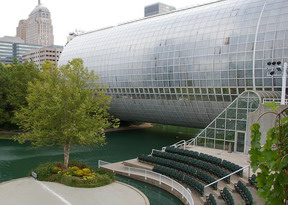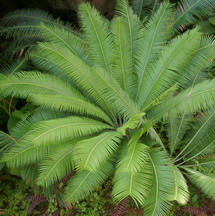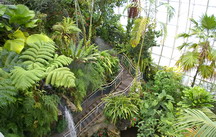|
Myriad Botanical Gardens
|


The Crystal Bridge is just that, as you can see from the photo above, of its exterior. It is a round tunnel of glass that is a bridge across the ponds and river that run through the central portion of the Myriad Botanical Garden. The interior is a cleverly divided habitat. There are no physical barriers but different climactic zones are kept functional by a heating and ventilating system that keeps one end as a moist tropical rain forest and the other end as a dry semi-arid mountain. Some plant genera such as the amazing Cycads, (photo left) have species that are endemic to both of these zones and this building allows that variety of them to be displayed as you wander through it. A few of these ancient plants make reasonable house plants.

Happy Houseplants
The arid mountain displays many types of plants that we would call succulents. These, sometimes thorny, delights are good suggestions for us to use as houseplants, as the hot dry conditions in the interior of many of our homes are similar to their native habitat. If we can provide sufficient light these easy to maintain plants will happily live with us for many years. Myriad Botanical Gardens' Crystal Bridge provides an excellent opportunity to observe these species and choose ones that you might want to give house room to.
The Wet End
At the other end of the building and of the climatic scale was the tropical rain forest. A delightful cascading waterfall helped to keep the humidity high enough to grow a wide variety of plants that, although very interesting, are difficult for us to keep as houseplants. There are several notable exceptions such as some Bromeliads and Spathiphyllum that are adaptable enough to survive in our dry indoor spaces and since they are understory plants in a thick jungle they often have a reduced light requirement.

Orchids Aplenty
One of the highlights of the conservatory at Myriad Botanical Gardens is the extensive Orchid collection. Hundreds of Orchids were blooming throughout the more humid sections of the Crystal Bridge. Most of these are epiphytes, which must be in the humid section, because they are a type of plant whose roots are simply wrapped around tree trunks and have no soil to obtain water from. The range of bloom size and colour makes it easy to see why many people try to grow these at home despite the difficulties in providing a suitable environment. One has to honestly admit that, without the blooms, most Orchid plants have little inherent beauty. ( How’s that for a polite way of saying ugly?)
 At Great Heights
At Great Heights
I love palm trees. It’s a silly habit to have since I live in Canada, (surprisingly, there are a few corners of this country that support a couple of palm species,) where Palm collections are hard?? to keep. The Crystal Bridge not only has an extensive Palm collection but one of its unique features is an upper walkway that allows visitors to wander through the waving fronds at the tops of these delightful trees. It is worth the visit to Myriad just to be able to become that intimate with the upper reaches of their palm collection. I went to spend an hour and spent the morning there. Apparently I missed some of the other delights of Oklahoma City by doing so but I thoroughly enjoyed my palm pleasures.
Get answers to your gardening questions by subscribing to
Ken’s free newsletter, Dallying In The Dirt
return from Myriad Botanical Gardens to Garden visits main page
